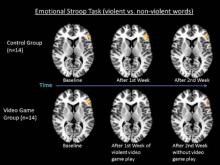CHICAGO – One week of violent video game play produced significant changes in brain function, a small study of men aged 18-28 shows.
Violent video games were associated with reduced activity in regions of the brain involved in attention, inhibition, and monitoring of emotions, Dr. Vincent P. Mathews, of Indiana University reported.
The study is one of the first to document the effects of violent video games on brain activity, Dr. Mathews said in a press briefing at the annual meeting of the Radiological Society of North America.
Although numerous behavioral studies have shown a correlation between violent video games and increased aggression, few neuroimaging studies have been done, said Dr. Mathews, of the Northwest Radiology Network in Indianapolis. Gathering that neurophysiologic data is important, because researchers believe the active role-playing involved in violent video games might make them more harmful than violent television shows or movies, he said.
The detrimental effects of violent video games described in behavioral studies include desensitization to violence; observational learning, in which repeated exposure to violent behavior is rewarded and aggressive behavior becomes encoded as appropriate; an increasingly hostile view of the world; and behavioral and cognitive scripts that might counteract positive environmental influences and in which violence can come to be seen as acceptable or even necessary.
Recent work by Dr. Mathews and his colleagues demonstrated the short-term effects of violent video games on brain function in adolescents. Functional magnetic resonance imaging (fMRI) revealed decreased activity in areas of the brain involved in inhibition and attention after 30 minutes of game time.
"In this study we wanted to look at longer-term violent video game play and its potential to alter brain function," Dr. Mathews said.
For the study, 28 young men, none of whom were heavy video game players, were randomized to experimental and control groups. The groups did not differ significantly in age, IQ, or video game experience.
Subjects in the video game group were given a computer loaded with a first-person shooter video game (industry-rated for mature audiences) for home use and were asked to play the game 2 hours daily for 1 week, followed by 1 week of no game play. Subjects averaged a total of 10 hours of game time. The control group refrained from video games throughout the study period.
Functional MRI was performed on all subjects at baseline, 1 week, and 2 weeks. Subjects performed two Stroop psychological tests: an emotional task and a counting task. The emotional task required participants to name the color of words in a series, which included both neutral (run, walk) and emotional (hit, kill) words. Emotionally charged words have been shown to produce a subconscious interference effect that results in a delayed response.
The counting task required subjects to view number words (two, three) and respond with the number of visual stimuli presented, not the words themselves (for example, the correct response to the word "three" shown twice would be "two"). This task also is designed to produce an interference effect.
Dr. Mathews and his colleagues looked specifically at changes in the dorsolateral prefrontal cortex, the area of the brain known to be most highly activated by the interference effect and an area involved in emotional modulation and inhibition, and the anterior cingulate cortex, which is involved in attention.
Statistical maps showed that brain activation in these regions remained unchanged in the nongame group from baseline to week 1 and week 2. Brain activation in the video game group did not differ significantly from the nongame group at baseline.
However, activation decreased significantly in the video game group, compared with the nongame group, after 1 week of daily violent video game playing. Activation in this group returned almost to baseline at week 2 after 1 week of no game playing. Maps of brain activation also showed significant differences in the video game group between baseline and week 1 and between weeks 1 and 2.
"What we’re seeing is that there’s a decrease in normal blood flow to that area after a week of playing violent games," Dr. Mathews said.
"Because the groups were randomly assigned and didn’t have any significant differences in their demographics, the differences can be assumed to be a result of the violent video game playing," he said. "Our results may be an explanation for these behavioral studies that show increased aggressive behavior following violent video games. So this actually is a physiologic explanation for what others have previously measured in behavioral studies."

